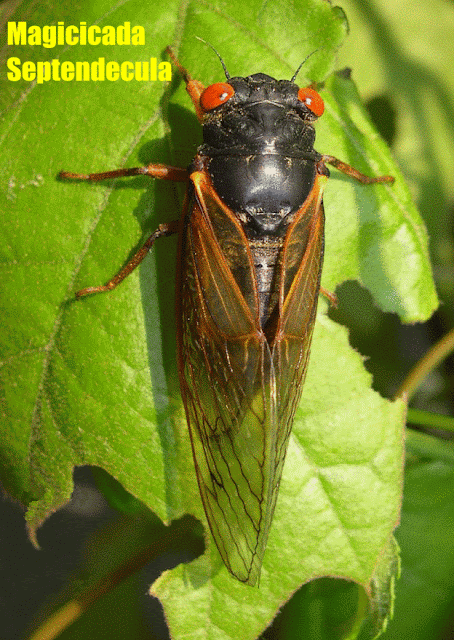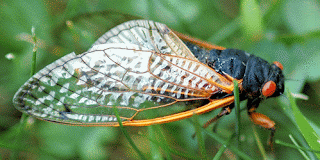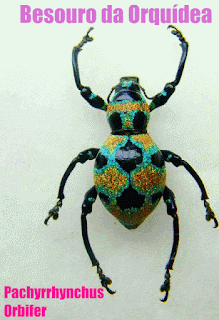As Cigarras Periódicas são diferentes de outras cigarras encontradas ao redor do mundo que aparecem anualmente. Levam mais tempo para se desenvolver (entre 13 e 17 anos) e emergem simultaneamente, não individualmente ou em pequenos grupos. Costumam ter olhos vermelhos e coloração diferente.
A partir de maio, na primavera do hemisfério Norte, trilhões de cigarras que passaram 17 anos vivendo debaixo da terra, começarão a emergir do solo, invadindo cidades e zonas rurais em 15 Estados (Delaware, Geórgia, Illinois, Indiana, Kentucky, Maryland, Michigan, Carolina do Norte, Nova Jersey, Nova York, Ohio, Pensilvânia, Tennessee, Virgínia, e West Virginia). São três espécies simultaneamente: Magicicada Septendecim, Magicicada Cassini e Magicicada Septendecula.
Nos EUA existem 15 dessas ninhadas de cigarras periódicas: 12 com ciclo de vida 17 anos e outras três com ciclo de 13 anos, o que faz com que, quase todos os anos, em alguma parte do país, um desses grupos esteja emergindo.
A Magicicada Septendecula é uma dessas espécies de inseto da família Cicadidae e é endêmica nos Estados Unidos.
O ciclo de vida médio da Magicicada Septendecula, desde o ovo até a morte natural na fase adulta é de cerca de dezessete anos. No entanto, seu ciclo de vida pode variar entre treze e vinte e um anos.
Geralmente menor que a Magicicada Septendecula e semelhante a Magicicada Cassini em tamanho, com listras laranjas estreitas e bem definidas na parte inferior do abdômen, mas sem coloração laranja na frente da inserção da asa atrás do olho. Esta espécie é freqüentemente muito mais rara do que Magicicada Septendecim e Magicicada Cassini.
O canto de chamada da espécie-irmã decula é ritmicamente diferente dos das outras duas formas e consiste em uma série de frases curtas com duração de 15 a 30 segundos. As duas primeiras canções de cortejo não foram bem caracterizadas, mas podem ter a mesma relação que as canções de corte das outras espécies. A escala tem 1 cm de comprimento.
Referências:
Alexander, R. D. and T. E. Moore. 1962. The evolutionary relationships of 17-year and 13-year cicadas, and three new species. (Homoptera: Cicadidae, Magicicada). University of Michigan Museum of Zoology Miscellaneous Publication 121:1-59.
Cooley, J. R. 2015. The distribution of periodical cicada (Magicicada) Brood I in 2012, with previously unreported disjunct populations (Hemiptera: Cicadidae). The American Entomologist 61:52-57.
Cooley, J. R., G. Kritsky, M. D. Edwards, J. D. Zyla, D. C. Marshall, K. B. R. Hill, G. J. Bunker, M. L. Neckermann, and C. Simon. 2011. Periodical cicadas (Magicicada spp.): The distribution of Broods XIV in 2008 and “XV” in 2009. The American Entomologist 57:144-151.
Cooley, J. R., G. Kritsky, J. D. Zyla, M. J. Edwards, C. Simon, D. C. Marshall, K. B. R. Hill, and R. Krauss. 2009. The distribution of periodical cicada Brood X. The American Entomologist 55:106-112.
Cooley, J. R., D. C. Marshall, A. F. Richards, R. D. Alexander, M. D. Irwin, J. R. Coelho, and C. Simon. 2013. The distribution of periodical cicada Brood III in 1997, with special emphasis on Illinois (Hemiptera: Magicicada spp.). The American Entomologist 59:9-14.
Cooley, J. R., C. Simon, C. Maier, D. C. Marshall, J. Yoshimura, S. M. Chiswell, M. D. Edwards, C. W. Holliday, R. Grantham, J. D. Zyla, R. L. Sanders, M. L. Neckermann, and G. J. Bunker. 2015. The distribution of periodical cicada (Magicicada) Brood II in 2013: Disjunct emergences suggest complex origins. The American Entomologist 61:245-251.
Dybas, H. S. 1969. The 17-year cicada: A four year mistake? Field Mus. Nat. Hist. Bull. 40:10-12.
Dybas, H. S. and D. D. Davis. 1962. A population census of seventeen-year periodical cicadas (Homoptera: Cicadidae: Magicicada). Ecology 43:432-444.
Heath, J. E. 1968. Thermal Synchronization of Emergence in Periodical "17-year" Cicadas (Homoptera, Cicadidae, Magicicada). Am. Midl. Nat. 80:440-448.
Karban, R. 1982. Increased reproductive success at high densities and predator satiation for periodical cicadas. Ecology 63:321-328.
Kritsky, G. 1987. An historical analysis of periodical cicadas in Indiana (Homoptera: Cicadidae). Proc. Indiana Acad. Sci. 97:295-322.
Kritsky, G. 1988. The 1987 emergence of the Periodical Cicada (Homoptera: Cicadidae: Magicicada spp.: Brood X) in Ohio. Ohio J. Sci. 88:168-170.
Kritsky, G. and S. Simon. 1996. The unexpected 1995 emergence of periodical cicadas (Homoptera: Cicadidae: Magicicada spp.) in Ohio. Ohio J. Sci. 96:27-28.
Kritsky, G. and F. N. Young. 1992. Observations on periodical cicadas (Brood XIV) in Indiana in 1991 (Homoptera: Cicadidae). Proc. Indiana Acad. Sci. 101:59-61.
Lloyd, M. and H. S. Dybas. 1966a. The periodical cicada problem. I. Population ecology. Evolution 20:133-149.
Lloyd, M. and H. S. Dybas. 1966b. The periodical cicada problem. II. Evolution. Evolution 20:466-505.
Lloyd, M. and J. A. White. 1976. Sympatry of periodical cicada broods and the hypothetical four-year acceleration. Evolution 30:786-801.
Maier, C. 1985. Brood VI of 17-year periodical cicadas, Magicicada spp. (Hemiptera: Homoptera: Cicadidae): New evidence from Connecticut (USA), the hypothetical 4-year deceleration, and the status of the brood. Journal of the New York Entomological Society 93:1019-1026.
Marlatt, C. L. 1923. The Periodical Cicada. United States Department of Agriculture, Bureau of Entomology Bulletin 71:1-183.
Marshall, D. C. 2001. Periodical cicada (Homoptera: Cicadidae) life-cycle variations, the historical emergence record, and the geographic stability of brood distributions. Ann. Entomol. Soc. Am. 94:386-399.
Marshall, D. C., J. R. Cooley, and K. B. R. Hill. 2011. Developmental plasticity in Magicicada: Thirteen year cicadas emerging in seventeen and twenty-one years (Hemiptera: Cicadidae). Ann. Entomol. Soc. Am. 104:443-450.
Marshall, D. C., J. R. Cooley, and C. Simon. 2003. Holocene climate shifts, life-cycle plasticity, and speciation in periodical cicadas: A reply to Cox and Carlton. Evolution 57:433-437.
Simon, C. 1988. Evolution of 13- and 17-year periodical cicadas. Bull. Entomol. Soc. Amer. 34:163-176.
Simon, C. and M. Lloyd. 1982. Disjunct synchronic population of 17-year periodical cicadas: Relicts or evidence of polyphyly? Journal of the New York Entomological Society 90:275-301.
Sota, T., S. Yamamoto, J. R. Cooley, K. B. R. Hill, C. Simon, and J. Yoshimura. 2013. Different histories of divergence into 13- and 17-year life cycles among three periodical cicada lineages. Proceedings of the
National Academy of Sciences of the United States of America 110:6919-6924.
White, J. and M. Lloyd. 1979. 17-Year cicadas emerging after 18 years: A new brood? Evolution 33:1193-1199.
Williams, K. S. and C. Simon. 1995. The ecology, behavior, and evolution of periodical cicadas. Annu. Rev. Entomol. 40:269-295.
Williams, K. S., K. G. Smith, and F. M. Stephen. 1993. Emergence of 13-yr periodical cicadas (Cicadidae: Magicicada): Phenology, mortality, and predator satiation. Ecology 74:1143-1152.

















Nenhum comentário:
Postar um comentário